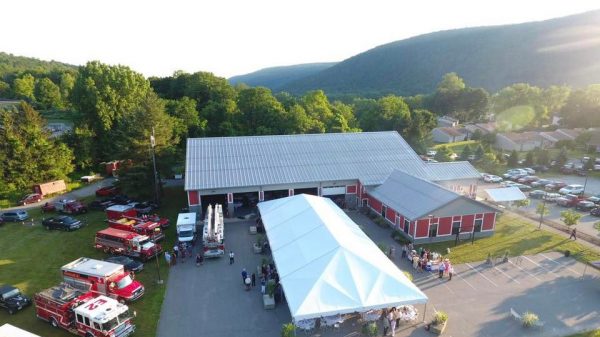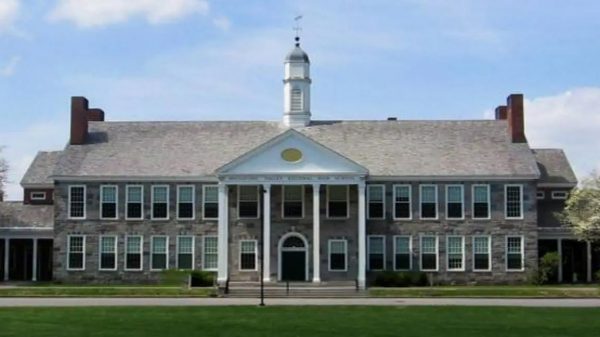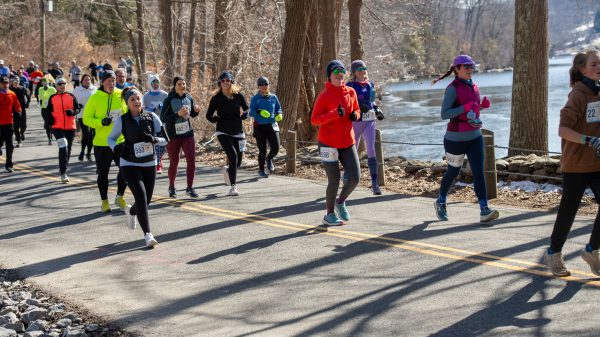KENT—Efforts are being made locally to help save one of America’s popular trees.

Nearly all the ash trees in a wide swath of the Midwest, New York State, and Southern New England have been destroyed by the Emerald Ash Borer (EAB), the larvae of which eat a tree’s inner bark, effectively girdling the tree’s circulatory system.
The inner bark does not grow back and within two to five years of infestation the tree dies from lack of food and water.
The effects of the insect, likely introduced inadvertently from Asia more than three decades ago, were first detected near Detroit in 2002.
States have attempted to contain it by using preemptive cutting of ash trees and by prohibiting importation of ash wood across state lines, but the EAB has spread rapidly across the landscape. Currently, it is found in 35 states and five Canadian provinces.
Recently, the Kent Land Trust heard a presentation by Ecological Research Institute Director, Jonathan Rosenthal, and senior scientist Radka Wildova, who described a program that offers hope for a newly EAB-resistant ash tree.
The research institute, located in New Palz, N.Y., has developed the Monitoring and Managing Ash (MaMA) program to identify “lingering ash,” trees that seem to be alive and thriving two years after 95 percent of the ash around them have died.
KLT Executive Director Connie Manes said after the meeting that the local land trust is eager to incorporate the ERI’s research into its stewardship and property management programs.
“We have added inventorying ash stands to our property monitoring this fall,” she said.
Additionally, land trust volunteers will monitor other “trees in peril” that are impacted by pests, disease and climate—including assessing the health of hemlock, beech and oak.
Rosenthal explained to the gathering at Kent Town Hall, that MaMA involves identifying trees that have apparent natural resistance to EAB larva through “mortality assessments.”

“Lingering ash are naturally occurring untreated mature trees that stay healthy two years after 95 percent of nearby trees have been killed,” he said. “Research led by the U.S. Forest Service has shown that selective breeding of ash trees derived from scions taken from lingering ash can yield highly EAB-resistant trees within two generations.”
The lingering ash seem to have a mechanism that kills the larvae that penetrate its bark, Rosenthal said.
“The larvae tunneling under the bark kills the trees,” he said. “You get tens of thousands of them meandering around in the circulatory system of the tree. The lingering ash tree will wall in the larva so it can’t move, and the larva dies.”
He said grafting scions (twigs) from resistant trees to rootstock is effective for propagating resistant offspring for all three species of ash, white, green and black.
“You can take multiple scions from a lingering ash and graft them to other trees and instantly have clonal progeny,” he explained. “It takes about two years for the clones to grow flowers and seeds.”
The researchers use green ash from susceptible trees for the rootstock. “If you use rootstock from resistant trees, you could get a bogus response,” he said. The susceptible rootstock is treated topically with an insecticide.
The U.S. Forest Service has shown scions from lingering ash can be used in selective breeding.
Rosenthal explained that EAB eggs are placed on the lingering ash clonal progeny and the number of larvae in successive stages are monitored to see if the tree kills a decent proportion.
Because ash trees have both male and female sexes, the next step is to cross the genetics of male and female resistant trees and to select for the second generation.
An Ohio breeding program is yielding positive results, but Rosenthal said bringing resistant trees from that state to Connecticut would not be productive because of the differences in soil and other factors. “You want as many trees adapted to the local environment as possible,” he said.
“New York State has been infested so long that 95 percent of the trees have been dead two years or more. We are far enough into the timescale so lingering ash can be identified. Northwest Connecticut is just about there, but looking before the mortality threshold is reached can yield spurious lingering ash.”
—Jonathan Rosenthal, Ecological Research Institute director
But care must be taken to ensure genetic diversity.
“If you are doing clonal propagation, you will end up with trees that are genetically identical” he said. “But that is not the case because we find as many as lingering ash as possible and do breeding, so there are multiple lines to multiply the genetic diversity. That is why we need land managers and citizen scientists. We need lots of people to for widespread data collection to find the trees.”
There has been intense pressure from some agencies and loggers to clear-cut ash trees before they lose their value, but Rosenthal argued that this also eliminates trees that might be resistant.
When a verified lingering ash is identified, it can be injected a chemical to prevent further infestation. Maintaining it in the landscape improves the environment for other trees.
“New York State has been infested so long that 95 percent of the trees have been dead two years or more,” Rosenthal explained. “We are far enough into the timescale so lingering ash can be identified. Northwest Connecticut is just about there, but looking before the mortality threshold is reached can yield spurious lingering ash.”
Another confusing factor can be new growth.
Rosenthal said that when the EAB has killed all the trees in an area, it has no food and its numbers plummet. “But it is always there,” he warned. “When new ash trees sprout, it is not because they are resistant, it’s because the EAB population is low. When the population crests again, it will kill all those new trees, too.”
The Ecological Research Institute is recruiting community science to create Rapid Ash Mortality Assessments (RAMAS) of crown health and signs of EAB infestation of 40 mature, chemically untreated, naturally occurring native ash at a chosen site.
The data enables assessment of when and where 95 percent EAB-induced ash mortality has been reached. Lingering ash that likely have some heritable resistance can then be identified.

Unlike the MaMA project, RAMA does not require a multi-year commitment and can be done more easily and quickly.
“All the information we get from the people we work with shows a lot of trees are dying more slowly,” he said.
“Populations can vary, particularly on the local level,” he said. “You will find patches of lingering ash. It could be populations differ, it could be patches where all the trees are related. It’s probably a combination of favorable environment and resistance, but I would not be surprised to see genetic differences.
“Our breeding information shows that some trees are repulsive to EAB,” he continued. “There is also evidence that smooth barks help, because EAB likes to lay eggs in crevices on host trees’ bark or under bark scales. The beauty of it is, it’s not a single resistance gene that could be overcome easily. We have an evolutionary arms race between the pest and the trees. For the trees, it’s better to have multiple sources of resistance.”
The program at town hall was sponsored by the Kent Land Trust, Litchfield Hills Greenprint Collaborative, a regional conservation partnership of Northwest Connecticut’s conservation organizations sponsored by the Housatonic Valley Association, and Pond Mountain Trust.




































